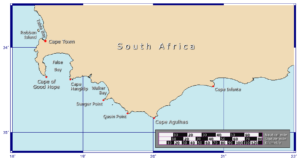In News: Recently, Bruno Werz, a maritime archaeologist and head of the African Institute for Marine and Underwater Research said “Over hundreds of years, the cape has been a hotspot for shipping accidents,”
About Cape of Good Hope

- Cape of Good Hope, rocky promontory at the southern end of Cape Peninsula, Western Cape province, South Africa.
- It was first sighted by the Portuguese navigator Bartolomeu Dias in 1488 on his return voyage to Portugal after ascertaining the southern limits of the African continent.
- One historical account says that Dias named it Cape of Storms and that John II of Portugal renamed it Cape of Good Hope (because its discovery was a good omen that India could be reached by sea from Europe); other sources attribute its present name to Dias himself.
- Known for the stormy weather and rough seas encountered there, the cape is situated at the convergence of the warm Mozambique-Agulhas current from the Indian Ocean and the cool Benguela current from Antarctic waters.
- Grass and low shrub vegetation is characteristic of the promontory, which is part of the Cape of Good Hope Nature Reserve (established 1939) that encompasses the southern tip of the peninsula.
- The term Cape of Good Hope is also used in three other ways:
- It is a section of the Table Mountain National Park, within which the cape of the same name, as well as Cape Point, falls. Prior to its incorporation into the national park, this section constituted the Cape Point Nature Reserve.
- It was the name of the early Cape Colony established by the Dutch in 1652, on the Cape Peninsula.
- Just before the Union of South Africa was formed, the term referred to the entire region that in 1910 was to become the Cape of Good Hope Province.
African Institute for Marine and Underwater Research, Exploration and Education (AIMURE)
- The African Institute for Marine and Underwater Research, Exploration and Education (AIMURE) was established in October 2012.
- The AIMURE is a non-profit and non-governmental organisation (NGO) that is registered with the South African Department of Social Development.
- The AIMURE was created to stimulate and support African marine, maritime and underwater studies.
- The Institute strives to be as inclusive as possible.
- Its geographical focus is the continent of Africa.
- The AIMURE is already recognized as a leader in its field by international scientists and organisations.
















